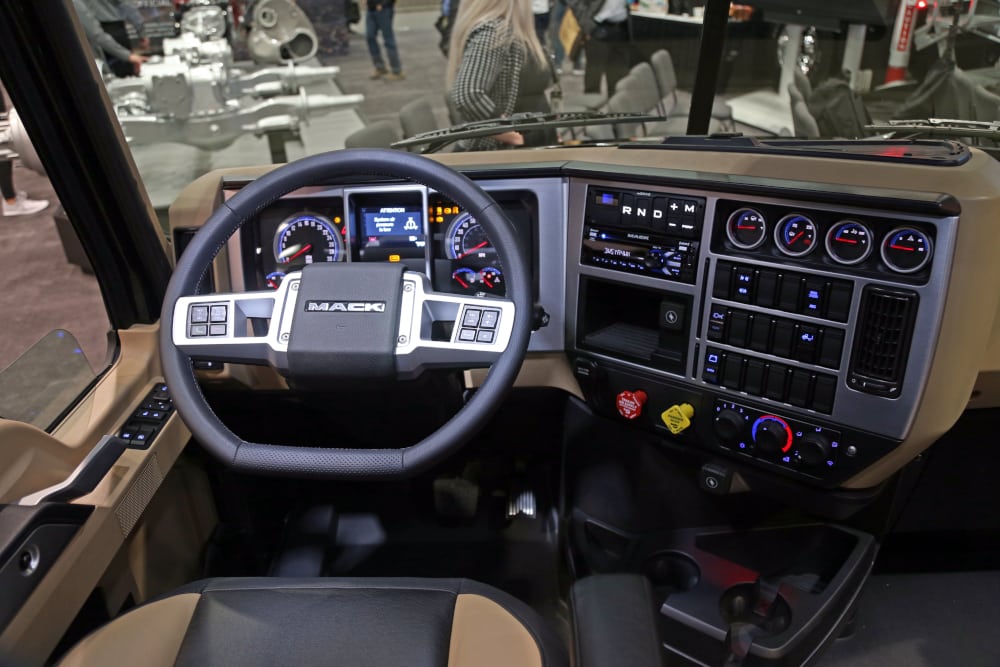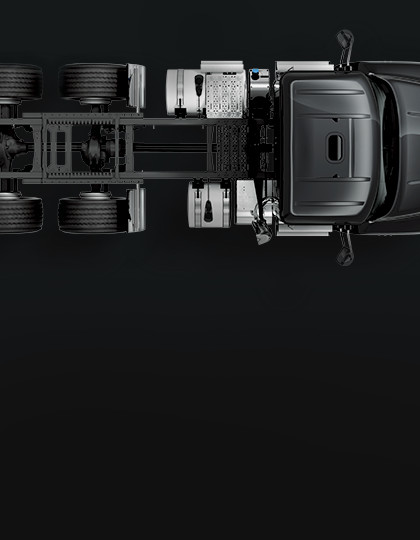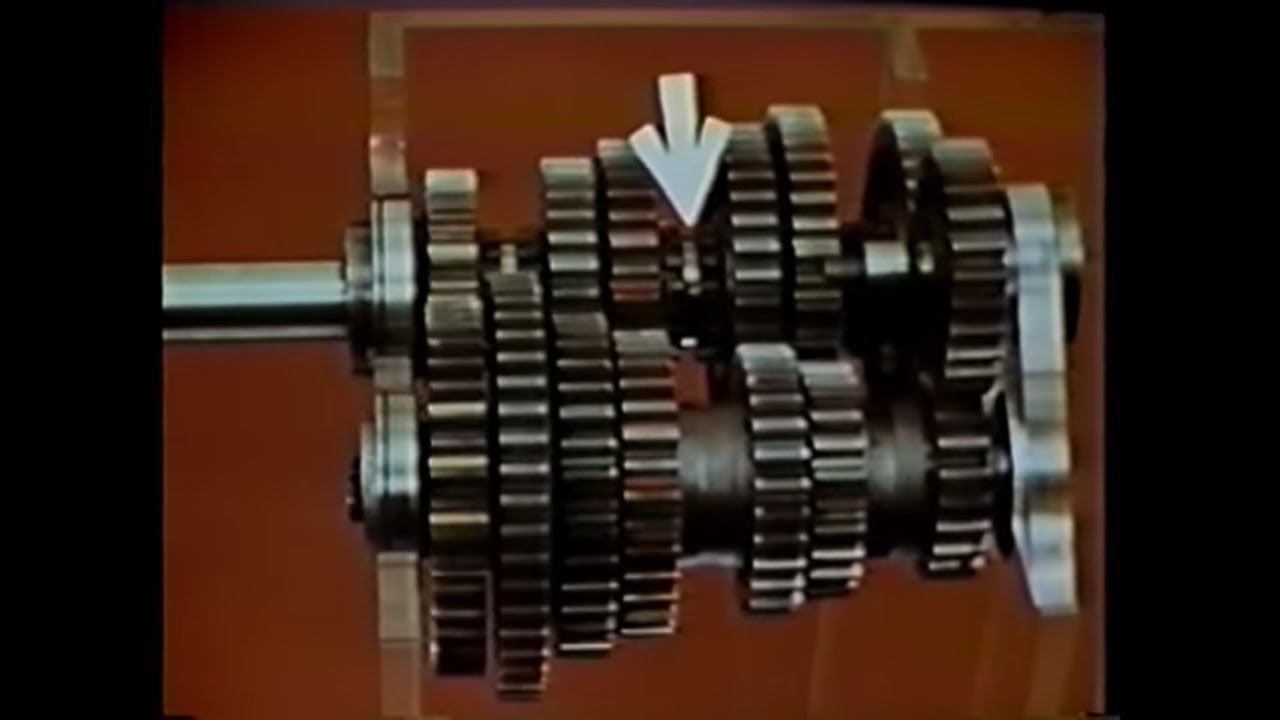Semi Trucks With Automatic Transmissions For Sale: A Comprehensive Guide pickup.truckstrend.com
The trucking industry, long synonymous with the skilled art of manual shifting, is undergoing a profound transformation. What was once a niche offering is now rapidly becoming the standard: semi trucks equipped with automatic transmissions. For sale across dealerships and online marketplaces, these vehicles represent a significant shift, promising enhanced driver comfort, improved fuel efficiency, and a broader appeal to a new generation of professional drivers. This comprehensive guide will delve into every aspect of semi trucks with automatic transmissions, from their operational benefits to the key considerations for potential buyers.
Introduction: The Dawn of Automated Driving in Heavy Haulage
Semi Trucks With Automatic Transmissions For Sale: A Comprehensive Guide
For decades, the rumble of a heavy-duty engine coupled with the precise, rhythmic engagement of a manual gear shifter defined the experience of a truck driver. Mastering the clutch, double-clutching, and finding the sweet spot for each shift was a badge of honor. However, the landscape is changing. "Semi Trucks With Automatic Transmissions For Sale" is no longer a rare sight but a dominant trend in the commercial vehicle market.
When we talk about "automatic transmissions" in semi-trucks, we are primarily referring to Automated Manual Transmissions (AMTs). Unlike the torque-converter automatics found in most passenger cars, AMTs are essentially manual transmissions with computer-controlled clutch and gear-shifting mechanisms. This design offers the best of both worlds: the robust efficiency of a manual gearbox combined with the convenience and intelligence of automated operation. This technological evolution is driven by several factors, including the need for greater operational efficiency, the desire to attract new drivers, and the relentless pursuit of enhanced safety and comfort on the nation’s highways.
The Evolution and Types of Automatic Transmissions in Heavy-Duty Trucks
The journey from purely manual to largely automated heavy-duty transmissions has been gradual but decisive. Early attempts at "automatic" systems were often clunky and inefficient, failing to match the performance and reliability of traditional manuals. However, significant advancements in electronics, software, and mechanical design have led to today’s highly sophisticated AMTs.
Modern AMTs, such as the Eaton Fuller UltraShift PLUS, Volvo I-Shift, Daimler Detroit DT12, and PACCAR TX-12, are not just about convenience; they are intelligent systems designed to optimize performance. They monitor engine RPM, road grade, vehicle speed, and even driver input to select the ideal gear for maximum fuel efficiency and power delivery.
While AMTs dominate the heavy-duty sector, it’s worth noting that traditional torque-converter automatics do exist in certain vocational applications (e.g., refuse trucks, some city delivery vehicles) where frequent stop-and-go driving benefits from their smooth, seamless power delivery. However, for line-haul and long-distance freight, AMTs are the undisputed champions due to their superior efficiency and durability.
Key Benefits of Automatic Semi Trucks
The rise in popularity of semi trucks with automatic transmissions is directly attributable to the tangible benefits they offer to drivers, fleet owners, and the industry as a whole.

- Enhanced Driver Comfort and Reduced Fatigue: This is perhaps the most immediate and appreciated benefit. Eliminating the need to constantly depress a clutch and manually shift gears significantly reduces physical strain, especially in heavy traffic or during long hauls. Drivers arrive at their destinations less fatigued, leading to a more pleasant work experience and improved alertness.
- Improved Fuel Efficiency: Modern AMTs are programmed to shift gears at optimal points, often more precisely and consistently than even the most experienced human driver. This precise shifting minimizes engine RPM fluctuations, keeps the engine in its most efficient power band, and reduces "lugging," all contributing to measurable fuel savings over time.
- Enhanced Safety: With no clutch pedal and no need to manually shift, drivers can keep both hands on the steering wheel and their eyes on the road, reducing distractions. This improved focus can lead to quicker reaction times and a lower risk of accidents, particularly in challenging driving conditions.
- Wider Driver Pool and Easier Training: The trucking industry faces a persistent driver shortage. Automatic transmissions lower the barrier to entry for new drivers, as the complex skill of manual shifting is no longer a prerequisite. This makes training faster and more accessible, attracting a more diverse group of individuals to the profession. Many new CDL holders are obtaining licenses with an "automatic restriction" because of the prevalence of these trucks.
- Reduced Maintenance Costs (Potentially): While the initial repair of an AMT can be complex, the system itself can reduce wear and tear on other components. Smoother shifts mean less shock loading on the driveline and tires. Crucially, clutch life is often significantly extended because the computer-controlled engagement is always perfect, eliminating driver-induced slippage or harsh engagement.
- Better Resale Value: As the industry continues its shift towards automatics, the demand for these trucks in the used market is increasing. This growing demand often translates into stronger resale values compared to their manual counterparts.

Important Considerations When Buying an Automatic Semi Truck
Purchasing a semi truck with an automatic transmission, whether new or used, requires careful consideration.

- Application: Your primary hauling needs will dictate the best truck and transmission combination. Are you doing long-haul, heavy-load, regional, or local delivery? Different AMT models and configurations are optimized for various applications. For instance, some AMTs have specific modes for heavy hauling or off-road conditions.
- Engine Compatibility: Ensure the automatic transmission is perfectly matched to the truck’s engine regarding horsepower and torque ratings. A mismatched system can lead to premature wear and performance issues. Reputable dealers will ensure this, but it’s crucial to verify when buying used.
- Specific Transmission Models: Familiarize yourself with the major players:
- Eaton Fuller UltraShift PLUS: Widely regarded, known for reliability and efficiency.
- Volvo I-Shift: Integrated seamlessly with Volvo engines, highly praised for smooth operation.
- Daimler Detroit DT12: Developed for Freightliner and Western Star trucks, known for its predictive capabilities.
- PACCAR TX-12: Designed for Kenworth and Peterbilt, integrated with PACCAR engines.
Each has its own characteristics, shifting logic, and service requirements.
- Mileage and Condition (for Used Trucks): As with any used vehicle, inspect the overall condition. For AMTs, specifically inquire about transmission service history, including fluid and filter changes. Look for signs of leaks or unusual noises during operation.
- Warranty: New trucks come with comprehensive warranties. For used automatics, consider purchasing an extended warranty, especially if the truck has high mileage or you plan to operate it extensively. Automatic transmission repairs can be costly, and a warranty can provide peace of mind.
- Driver Adaptation: While easier to drive, experienced manual drivers may need a period of adaptation to automatic transmissions. Encourage them to trust the system and understand its features, such as manual override modes or economy settings.
Where to Find Automatic Semi Trucks For Sale
The market for automatic semi trucks is robust and growing. You can find them through various channels:
- Authorized Dealerships: Ideal for new trucks, offering the latest models, manufacturer warranties, and financing options. Many also have certified used truck programs.
- Online Marketplaces: Websites like TruckPaper.com, CommercialTruckTrader.com, MyLittleSalesman.com, and RitchieSpecs.com are excellent resources for finding a wide range of new and used trucks from various sellers across North America.
- Auctions: Public and private auctions (e.g., Ritchie Bros. Auctioneers, IronPlanet) often feature fleet liquidations, which can be a source for well-maintained automatic trucks, though they typically sell "as-is."
- Direct from Fleets: Some larger fleets sell off older equipment directly. This can be a good source for trucks with known service histories, though they may require more searching.
Tips for Inspecting and Test Driving an Automatic Semi Truck
A thorough inspection and test drive are crucial for any truck purchase, especially for one with an automatic transmission.
- Review Service Records: This is paramount. Look for consistent maintenance, especially transmission fluid and filter changes, and any records of diagnostic work or repairs related to the transmission.
- Visual Inspection: Check for any fluid leaks around the transmission housing. Look for signs of damage or unusual wear.
- Test Drive:
- Smooth Shifting: Pay close attention to how the transmission shifts through gears, both up and down. Shifts should be smooth, predictable, and without harsh jerks or delays.
- Noises: Listen for any unusual grinding, whining, or clunking noises from the transmission.
- Engagement: Ensure the transmission engages promptly when shifting from neutral to drive or reverse.
- Performance Modes: If applicable, test different modes (e.g., economy, performance, manual override) to ensure they function correctly.
- Engine Braking: Verify that the engine brake (jake brake) or exhaust brake integrates smoothly with the transmission’s downshifting logic.
- Diagnostic Scan: If possible, have a qualified technician perform a diagnostic scan of the transmission’s electronic control unit (ECU) to check for any stored fault codes that might indicate underlying issues.
Challenges and Solutions
While the benefits are clear, there can be some challenges associated with automatic semi trucks:
- Initial Cost: New automatic trucks can sometimes have a higher upfront price than their manual counterparts.
- Solution: Explore the robust used market, where prices are more competitive. Consider financing options to spread the cost.
- Perceived Lack of Control: Some veteran drivers, accustomed to manuals, may initially feel a loss of control or engagement with an automatic.
- Solution: Driver training and education on the capabilities of modern AMTs, including manual mode overrides and advanced features, can help overcome this resistance. Demonstrating fuel savings and reduced fatigue often wins them over.
- Repair Complexity/Cost: While more reliable, when an AMT does require repair, it can be more complex and potentially more expensive than a simple manual gearbox.
- Solution: Rely on reputable service centers with trained technicians specializing in AMTs. Comprehensive pre-purchase inspections and extended warranties can mitigate financial risk.
- Driver Resistance: Changing deeply ingrained habits can be difficult.
- Solution: Fleet owners can implement phased transitions, provide thorough training, and highlight the long-term benefits to drivers.
Price Table: Semi Trucks With Automatic Transmissions For Sale (Estimated Ranges)
Please note: Prices are highly variable and depend on numerous factors including specific make/model, year, mileage, condition, engine, additional features, market demand, and geographic location. The ranges provided below are illustrative estimates only.
| Category | Make/Model Examples | Year Range | Mileage Range (miles) | Price Range (USD) | Key Features (Automatic Trans.) |
|---|---|---|---|---|---|
| New (Sleeper Cab) | Freightliner Cascadia, Volvo VNL, Kenworth T680, Peterbilt 579, International LT | 2023-2024 | 0 – 10,000 | $160,000 – $220,000+ | Latest generation AMTs (e.g., DT12, I-Shift, TX-12, UltraShift PLUS), advanced safety systems, full factory warranty, premium comfort features, high fuel efficiency packages. |
| Used (Newer Sleeper) | Freightliner Cascadia, Volvo VNL, Peterbilt 579, Kenworth T680, International LT | 2019-2022 | 200,000 – 500,000 | $70,000 – $140,000 | Advanced AMTs, typically well-maintained, still under some OEM or extended warranty options, good balance of modern tech and value, often with aerodynamic packages. |
| Used (Older Sleeper) | Freightliner Cascadia, Volvo VNL, International ProStar, Kenworth T680 | 2015-2018 | 500,000 – 800,000 | $40,000 – $70,000 | Established AMT models (e.g., early UltraShift PLUS, I-Shift), higher mileage, may require more immediate maintenance, but offer significant cost savings for entry-level or budget-conscious buyers. |
| Used (Day Cab) | Freightliner M2, Volvo VNL Day Cab, International RH, Kenworth T880 Day Cab | 2017-2022 | 250,000 – 600,000 | $50,000 – $100,000 | Ideal for local/regional hauling, vocational applications, durable AMTs designed for frequent stops and starts, often higher engine hours but lower road mileage, good maneuverability. |
| Specialized (Heavy Haul/Vocational) | Kenworth W900 (with AMT), Peterbilt 389 (with AMT), Mack Anthem (with mDRIVE) | 2018-2023 | 100,000 – 400,000 | $100,000 – $180,000+ | Robust AMTs engineered for high Gross Combination Weight Ratings (GCWR) and demanding applications, often feature specific heavy-haul modes, reinforced chassis, and powerful engines. Prices vary wildly with customization. |
Frequently Asked Questions (FAQ) about Semi Trucks With Automatic Transmissions For Sale
Q1: Are automatic semi-trucks really more fuel-efficient than manuals?
A1: Yes, generally. Modern Automated Manual Transmissions (AMTs) are programmed to shift gears at optimal engine RPMs, ensuring the engine operates within its most efficient range. This precise, consistent shifting often results in better fuel economy compared to a human driver, whose shifting habits can vary.
Q2: Do automatic semi-trucks have a clutch pedal?
A2: No. One of the primary benefits of an AMT is the elimination of the clutch pedal. The computer handles the clutch engagement and disengagement automatically, simplifying the driving experience.
Q3: Is it harder to get a CDL with an automatic restriction?
A3: No, it’s actually easier to obtain a Commercial Driver’s License (CDL) if you only train and test on an automatic transmission, as it removes the complex skill of manual shifting. However, if you obtain your CDL with an automatic transmission and later wish to drive a manual, you will need to re-test on a manual transmission to remove the "automatic restriction" from your license.
Q4: Are automatic semi-trucks more expensive to maintain or repair?
A4: While the initial cost of a new AMT-equipped truck might be slightly higher, and complex repairs can be more specialized, they often lead to reduced overall maintenance costs. This is primarily due to significantly extended clutch life (as the computer always engages it perfectly) and less wear and tear on other driveline components from smoother shifts. Proper maintenance and reputable service are key.
Q5: Can I still "engine brake" with an automatic transmission?
A5: Absolutely. Modern automatic transmissions are fully integrated with the truck’s engine braking system (often called a "jake brake" or exhaust brake). The transmission’s control unit will automatically downshift to assist the engine brake in slowing the vehicle and maintaining control, especially on descents. Many AMTs also offer a "manual mode" or specific settings to allow the driver to select and hold gears for better engine braking control.
Q6: What’s the difference between an AMT and a "true" automatic (like in a car)?
A6: A "true" automatic transmission, common in passenger cars, uses a torque converter to transfer power from the engine to the transmission, providing seamless, clutch-less shifts. An Automated Manual Transmission (AMT), on the other hand, is fundamentally a manual gearbox with an automated clutch and gear-shifting mechanism. It uses actuators and sensors controlled by a computer to perform the shifts. AMTs are preferred in heavy-duty trucks for their superior fuel efficiency, durability, and ability to handle high torque loads with minimal power loss compared to traditional torque-converter automatics.
Q7: Are automatic transmissions reliable in heavy-duty trucks?
A7: Yes, modern AMTs are highly reliable. They have undergone years of development and rigorous testing. Major manufacturers like Eaton, Volvo, Daimler, and PACCAR have invested heavily in their AMT technology, resulting in robust, durable, and efficient systems designed for the demands of commercial trucking. Like any complex component, regular maintenance is crucial for longevity.
Conclusion: The Future is Automated
The presence of "Semi Trucks With Automatic Transmissions For Sale" is a clear indicator of the trucking industry’s direction. These vehicles offer a compelling package of benefits, from significantly enhanced driver comfort and reduced fatigue to measurable improvements in fuel efficiency and safety. While the traditional manual gearbox will always hold a place in trucking history, the undeniable advantages of automated transmissions are driving their rapid adoption.
For fleet owners, they represent a strategic investment in operational efficiency, driver retention, and the ability to tap into a wider pool of qualified drivers. For individual owner-operators, they offer a less physically demanding and potentially more profitable way to navigate the highways. As technology continues to advance, the automatic semi truck is not just a trend; it is the definitive future of heavy-duty transportation, promising a smoother, safer, and more efficient journey for all.


